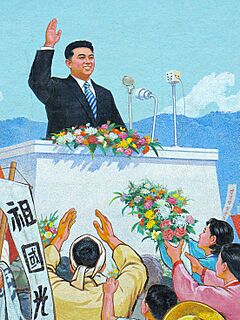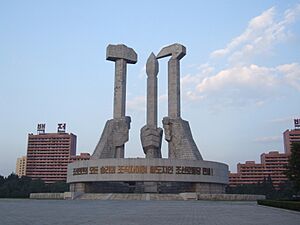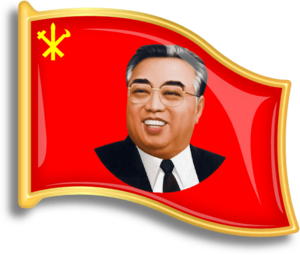Workers' Party of Korea facts for kids
Quick facts for kids
Workers' Party of Korea
조선로동당
|
|
|---|---|
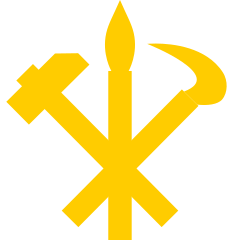 |
|
| Abbreviation | WPK |
| General Secretary | Kim Jong Un |
| Presidium |
|
| Founded | 24 June 1949 |
| Merger of |
|
| Headquarters | Government Complex No. 1, Chung-guyok, Pyongyang |
| Newspaper | Rodong Sinmun |
| Youth wing | Socialist Patriotic Youth League |
| Women's wing | Socialist Women's Union of Korea |
| Children's wing | Korean Children's Union |
| Armed wing | Korean People's Army |
| Paramilitary wing | Worker-Peasant Red Guards |
| Membership (2021 est.) | |
| Ideology | |
| National affiliation | DFRK (1949–2024) |
| Regional affiliation | Anti-Imperialist National Democratic Front |
| International affiliation | IMCWP |
| Colors | Red |
| Anthem | "Long Live the Workers' Party of Korea" |
| Status | Ruling party in North Korea; outlawed in South Korea under the National Security Act |
| Party flag | |
 |
|
| Workers' Party of Korea | |||||||
|---|---|---|---|---|---|---|---|
| North Korean name | |||||||
| Chosŏn'gŭl | 조선로동당 | ||||||
| Hancha | 朝鮮勞動黨 | ||||||
|
|||||||
| South Korean name | |||||||
| Hangul | 북한노동당 | ||||||
| Hanja | 北韓勞動黨 | ||||||
|
|||||||
The Workers' Party of Korea (WPK), also called the Korean Workers' Party (KWP), is the main political party in North Korea. It is the only party that truly holds power in the country. The WPK was started in 1949 when two other parties joined together. It is the oldest active political party in Korea. The WPK also controls the Korean People's Army, which is North Korea's military. While there are two other legal parties in North Korea, they must follow the WPK's lead. The WPK is not allowed in South Korea and has faced restrictions from the United Nations and other countries.
The WPK officially follows an idea called Kimilsungism–Kimjongilism. This idea combines the teachings of North Korea's past leaders, Kim Il Sung and Kim Jong Il. The party also believes in Juche, which means national independence and developing the country through the efforts of its people. Juche was first seen as North Korea's version of Marxism–Leninism, but now it is presented as its own unique philosophy.
The WPK believes that the ruling Kim family is the most important source of its political ideas. In 2012, the party changed its rules to say that Kimilsungism–Kimjongilism was "the only guiding idea of the party." For a while, under Kim Jong Il, the idea of Songun, or "military-first" politics, became very important. This meant the military was seen as the main source of power. However, the current leader, Kim Jong Un, changed this in 2021. He replaced Songun with "people-first politics" and brought back the party's focus on communism.
The WPK is organized using a system called the Monolithic Ideological System. This system was created by Kim Yong-ju and Kim Jong Il. The highest official group in the WPK is supposed to be the party congress. However, before Kim Jong Un became leader, these meetings rarely happened. For example, no congresses were held between 1980 and 2016. Even though the WPK looks like other communist parties in how it's set up, in reality, informal decisions often play a bigger role than the official rules. Groups like the Central Committee and the Politburo have less power than what the rules say. Kim Jong Un is the current leader of the party, holding the title of General Secretary of the WPK.
The Party's Story
How the Party Started (1945–1953)
The Workers' Party of Korea has a long history. It began on October 13, 1945, when a group called the North Korean Bureau of the Communist Party of Korea was formed. At first, this group was part of a larger Communist Party based in Seoul. Later, in 1946, Kim Il Sung became its leader.
In July 1946, Soviet officials in North Korea helped create a group called the United Democratic National Front. Soon after, the Communist Party of North Korea joined with another party called the New People's Party of Korea. This merger created the Workers' Party of North Korea (WPNK) in August 1946. Even though Kim Tu-bong was the official chairman, Kim Il Sung was still the main leader.
The WPNK gained more control across the country. In April 1948, a special meeting approved a new constitution. This led to the official creation of an independent North Korea. The goal was a united Korea under a communist government, with Seoul as the capital. Kim Il Sung became the head of the new government. A year later, on June 24, 1949, the Workers' Party of Korea was formed by combining the WPNK and the Workers' Party of South Korea.
In June 1950, North Korea invaded South Korea, starting the Korean War. The war almost caused North Korea to fall, but China helped them. The war also made Kim Il Sung less influenced by the Soviet Union. During this time, different groups, or "factions," formed within the WPK. These included groups who stayed in Korea during Japanese rule, Koreans from the Soviet Union, Koreans from China, and Kim Il Sung's own group. Kim Il Sung worked to strengthen his power after the war ended.
Kim Il Sung Takes Full Control (1953–1980)
Relations between the WPK and the Soviet Union became difficult when the new Soviet leader, Nikita Khrushchev, started to move away from Stalinism. During a disagreement between the Soviet Union and China, Kim Il Sung carefully managed his relationships with both. By doing this, he reduced their influence over the WPK. Kim Il Sung did not like the idea of criticizing Stalinism or having a group of leaders instead of one strong leader. He knew that these changes would end his unlimited power in North Korea. Because of these disagreements, the Soviet Union stopped sending aid to North Korea.
China was not able to increase its aid, which caused problems for many industries in North Korea. China's leader, Mao Zedong, then started the Cultural Revolution, which the WPK criticized. As relations between the Soviet Union and China became more stable, the WPK decided to stay neutral. This led to the start of the Juche program in 1966, which focused on national self-reliance. This helped Kim Il Sung become even stronger in the WPK.
Starting in the 1960s, Kim Il Sung's public image grew very strong. By 1972, his birthday on April 15 became a major national holiday, and statues of him were built everywhere. He was called "Great Leader" and "Sun of the Nation" in party writings. Official messages said that "burning loyalty to the leader" was a key quality for all Koreans.
Kim Il Sung and his group removed other factions from the WPK during the 1950s and 1960s. This happened even though China and the Soviet Union were unhappy about it. First, the domestic faction was removed (1953–55), then the Chinese faction (1957–58), and finally the Soviet Koreans (1957–62). Historian Andrei Lankov noted that Kim Il Sung became the "omnipotent ruler of North Korea." After removing his opponents, Kim Il Sung strengthened his power by giving important jobs to family members and people from his own group. By the late 1980s, many high-ranking officials were sons of other high-ranking officials.
Since the 1960s, Kim Il Sung had appointed family members to powerful positions. By the early 1990s, many top national jobs were held by people related to him. These individuals were appointed because of their family ties to the Kim family. Kim supported this system because he did not want the party's officials to threaten his or his son's rule, as happened in other socialist countries.
Many foreign observers first thought that Kim Il Sung's brother, Kim Yong-ju, would take over after him. Kim Yong-ju's power grew for a while. However, by the time of the 6th WPK Congress, Kim Yong-ju became less important. At this congress, he lost his positions. Rumors that Kim Il Sung had been preparing his son, Kim Jong Il, to take over since 1966 were confirmed. From 1974 until the 6th Congress, Kim Jong Il was the second most powerful person in North Korea. Some people criticized his selection, saying his father was creating a family dynasty.
Kim Jong Il's Time as Leader (1980–2011)
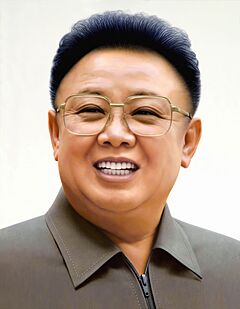
When Kim Jong Il was officially named the next leader at the 6th Congress, power became even more focused on the Kim family. Party officials openly talked about his future leadership. In 1982, he was given the title of Hero of the Democratic People's Republic of Korea and wrote a book called On the Juche Idea. While some thought Kim Jong Il's leadership would bring in younger leaders, his book made it clear that his rule would not change the leadership style. The WPK struggled to deal with problems at home and abroad, partly because many of the top leaders were very old.
After O Jin-u passed away in February 1995, Kim Jong Il became the only living member of the Presidium, which is the WPK's highest group when other bodies are not meeting. For the WPK's 50th anniversary, Kim Jong Il reorganized the military leadership to please both older and younger officials. However, he did not change the WPK Central Committee or the government much during the 1990s; changes happened mostly when members passed away.
Starting in 1995, Kim Jong Il favored the military over the WPK and the government. Problems grew as an economic crisis and a severe famine caused many people to die. Instead of making big changes, Kim criticized the WPK for not controlling the economy well. He said that people were loyal to the Central Committee's instructions because of his authority, not because of the party. After this, the WPK's job of controlling the economy was given to the central government. By late 1996, Kim Jong Il decided that neither the WPK nor the government could run the country, so he started giving more control to the military. In 1998, a change to the constitution gave the military's leadership the highest state power, not the WPK.
On July 8, 1997, the three-year mourning period for Kim Il Sung ended. Later that year, on October 8, Kim Jong Il was given the new title of General Secretary of the Workers' Party of Korea. It was unusual because he was appointed by the Central Committee and the military, not elected by a party meeting. Many thought he would call a party congress soon after to elect new leaders, but he did not. The WPK did not have a major organizational meeting until the 3rd Conference in 2010.
Until then, Kim Jong Il ruled with almost complete power. New members were only appointed to important WPK groups when older officials passed away. In September 1998, the North Korean constitution was changed. This made the National Defense Commission (NDC), which oversaw the military, the highest state body. Even though the new constitution gave the cabinet and NDC more freedom from WPK officials, it did not weaken the party. Kim Jong Il remained the WPK General Secretary and controlled important party departments. While the central WPK leadership was not fully renewed until 2010, the WPK still played a key role in organizing people.
On June 26, 2010, the Politburo announced a 3rd Party Conference. They said it was needed to "reflect the demands of the revolutionary development of the Party." The conference took place on September 28. It updated the party rules and elected new members to various party groups. Kim Jong Un was confirmed as the next leader. Important military and party leaders, like Ri Yong-ho and Kim Kyong-hui (Kim Jong Il's sister), were appointed to help him gain power. The next year, on December 17, 2011, Kim Jong Il passed away.
Kim Jong Un's Leadership (2011–Present)

After Kim Jong Il's passing, North Korea's leaders quickly made sure Kim Jong Un took power. He was announced as the country's leader on December 19, 2011. On December 26, the official newspaper Rodong Sinmun called him the supreme leader of the party and the state. On December 30, a Politburo meeting officially named him Supreme Commander of the Korean People's Army. Even though he was not a Politburo member at the time, Kim Jong Un was recognized as the supreme leader of the Workers' Party of Korea.
After celebrations for Kim Jong Il's 70th birthday, the Politburo announced on February 18, 2012, that the 4th Party Conference would be held in mid-April. This conference was meant to honor Kim Jong Il and continue the Juche cause under Kim Jong Un. In July 2012, Kim Jong Un was promoted to the rank of "Marshal of the Republic." At the 4th Party Conference on April 11, Kim Jong Il was declared "Eternal General Secretary." Kim Jong Un was elected to the new position of First Secretary of the Workers' Party of Korea. The conference also changed the party rules to state that Kimilsungism–Kimjongilism was "the only guiding idea of the party." In December 2013, the party saw a rare public struggle when Jang Song-thaek was removed from power.
The party has become more active under Kim Jong Un. There have been two conferences and a congress between 2010 and 2016, after a long break of 44 years. After a large military parade for the party's 70th anniversary on October 10, 2015, the Politburo announced that the 7th Congress would be held on May 6, 2016, after 36 years. This congress announced the first Five-Year Plan since the 1980s and gave Kim Jong Un the new title of chairman, replacing First Secretary.
In January 2021, the 8th WPK Congress took place. Here, Kim Jong Un was given the title of general secretary, replacing chairman. This congress also showed that the WPK was gaining more control over the army, with fewer military representatives in the congress and Politburo. Kim's sister, Kim Yo Jong, was appointed to the Politburo. In June 2021, it was reported that the party created a new post of 'First Secretary'. Since 2021, Kim Jong Un has been bringing back communist ideas and words within the WPK, and the ideology is again written into the party rules. He has also increasingly replaced Songun with "people-first politics" in the party rules.
Party Ideas and Beliefs
The WPK presents itself as a leftist party. It often sends representatives to international meetings of communist and workers' parties. The WPK also sees itself as part of worldwide leftist and socialist movements. During the Cold War, the WPK and North Korea aimed to "export revolution" by helping leftist groups around the world. The party rules state that its main goal is to "realize a communist society" and that it follows "the revolutionary principles of Marxism–Leninism." However, some experts like Brian Reynolds Myers say that the WPK's ideas are also very nationalistic and focus on Korean identity.
Juche
Juche is a key idea in North Korea. It means that "man is the master of everything and decides everything." This idea is similar to Marxist–Leninist thought, which believes history follows certain rules. However, Juche emphasizes that only people drive progress, and "the popular masses are the drivers of history."
From the Juche viewpoint, the struggle for people to make their own history is held back by ruling classes. Only the working class can overcome these limits and create a society where people can freely and creatively make their own history. Juche believes that humanity's ability to shape its own history is the result of a long process, which began with capitalism bringing about the working class. Therefore, Juche is unique to the socialist era.
However, for the people to succeed, they need a Great Leader. In North Korea, a single Great Leader is seen as essential. This idea helped Kim Il Sung create a system where one person had all the power.
This theory makes the Great Leader an absolute, supreme leader. The working class does not think for itself but through the Great Leader. He is seen as the brilliant mind of the working class and its only true representative. Difficult tasks and big changes can only happen through him. So, in history, the Great Leader is the main force of the working class. He is seen as a perfect person who never makes mistakes, is always kind, and rules for the good of the people. For this Great Leader system to work, everyone must follow one single idea. In North Korea, this is called the Monolithic Ideological System.
The Kim Family's Role
The Kim family's rule began with Kim Il Sung, the first leader of the WPK and North Korea. The official belief is that the North Korean system works well because Kim Il Sung created it, and his successors follow his family line. Every child learns about "the revolutionary history of the Great Leader" and "the revolutionary history of the Dear Leader" (Kim Jong Il). Kim Il Sung first thought his brother, Kim Yong-ju, would take over. But he later chose his son, Kim Jong Il. This decision was made official at the 6th Congress. Kim Jong Il chose his youngest son, Kim Jong Un, as his successor at the 3rd WPK Conference in 2010, and his son took over in early 2011. Because of this family succession and the appointment of family members to high positions, the Kim family has been called a dynasty or a royal family. Some experts describe the ruling Kim family as leading a "hereditary dictatorship."
Monolithic Ideological System
The Ten Principles for the Establishment of a Monolithic Ideological System are a set of ten rules and 65 smaller points. These rules set standards for how the country is run and guide how people in North Korea should behave. The Ten Principles have become even more important than the national constitution or rules from the Workers' Party. In practice, they act as the highest law in the country.
Songbun
Songbun is the name for a system that was set up on May 30, 1957, by the WPK Politburo. This system led to a check of every person in North Korean society to see how loyal they were to the party and its leader. This check began in 1959.
People in North Korea were divided into three groups: hostile, neutral, or friendly. The group a person belonged to was passed down through their family. People in the "hostile" group cannot live near Pyongyang (the capital) or other big cities, or near North Korea's borders. Songbun affects a person's chances for education and jobs, and especially whether they can join the WPK. However, its importance has lessened since the 1990s due to changes in other communist countries and problems with North Korea's economy.
The North Korean government, however, says that all citizens are equal and denies any unfair treatment based on family background.
How the Party is Organized
Central Leadership
The Congress is the party's highest group, but it meets only sometimes. The party rules say the Central Committee can call a congress if it gives the party at least six months' notice. The Congress has seven main jobs:
- Electing the Central Committee
- Electing the Central Auditing Commission
- Electing the General Secretary
- Looking at reports from the old Central Committee
- Looking at reports from the old Central Auditing Commission
- Talking about and creating party policies
- Changing the party rules
When the Congress is not meeting, the Central Committee is the highest decision-making group. The Central Auditing Commission checks the party's money and works separately from the Central Committee. The Central Committee chooses the members of several groups to help it work. The first meeting of a new Central Committee chooses the Central Military Commission (CMC), the Secretariat, the Politburo, and the Presidium. The Politburo takes over the Central Committee's duties when it is not meeting. The Presidium is the party's highest decision-making group when the Politburo, Central Committee, and Congress are not meeting. It was created in 1980.
The CMC is the top group for military decisions within the party and controls the Korean People's Army. The WPK General Secretary is automatically the Chairman of the CMC. The Secretariat is the main group that carries out decisions. It is led by the WPK General Secretary and includes several secretaries who usually lead different departments. The Central Auditing Commission handles problems with party members, from minor issues to serious rule-breaking.
The first meeting of the Central Committee also chooses the heads of departments and other groups. The WPK currently has more than 15 Central Committee departments. Through these departments, it controls many organizations and newspapers, like Rodong Sinmun. The Korean People's Army (KPA) is, according to WPK rules, the "revolutionary armed power of the Workers' Party of Korea." The main group within the KPA is the General Political Bureau (GPB). The GPB controls the party's work and all political officers within the KPA.
Local Party Groups
The WPK has local groups for the three levels of local government in North Korea: provinces, cities, and rural areas. North Korea has nine provinces, each with its own party committee. The WPK decides who is on these committees.
The WPK has two types of members: regular and probationary. To become a member, you must be 18 or older and submit an application. Two current party members who have been in good standing for at least two years must support your application. The local party group decides on the application, and a county-level party committee must approve it. After approval, there is usually a one-year trial period, but this can be skipped in "special circumstances." The Organization and Guidance Department manages who joins the party.
In 1988, the WPK said it had over three million members, a big increase from two million in 1976. At that time, 12 percent of the population were party members, which is a very high number for a communist country. Newer numbers are not public, but today, membership is estimated at 6.5 million.
North Korean society is divided into three groups: industrial workers, farmers, and samuwon (intellectuals and small business owners). Since 1948, industrial workers have been the largest group of party members, followed by farmers and samuwon. In the 1970s, as more people lived in cities, the makeup of party groups changed. More people working in state-owned businesses became party members, and fewer members were in farming cooperatives.
Party Symbols
The WPK's symbol is like the communist hammer and sickle, but it also includes a traditional Korean calligraphy brush. These symbols represent the three groups in Korean society, as described by the WPK: the industrial workers (hammer), the farmers (sickle), and the samuwon (ink brush). The samuwon group includes clerks, small traders, government workers, teachers, and writers. This group is unique to North Korean ideas about society and was created to encourage education and reading among the people.
The party's official song is called "Long Live the Workers' Party of Korea" (조선로동당 만세) and was created in 1980.
Election Results
| Election | Party leader | Seats | +/– | Position |
|---|---|---|---|---|
| 1948 | Kim Il Sung |
157 / 572
|
||
| 1957 |
178 / 215
|
|||
| 1962 |
371 / 383
|
|||
| 1967 |
288 / 457
|
|||
| 1972 |
127 / 541
|
|||
| 1977 | [data missing] | |||
| 1982 | [data missing] | |||
| 1986 | [data missing] | |||
| 1990 |
601 / 687
|
|||
| 1998 | Kim Jong Il |
594 / 687
|
||
| 2003 | [data missing] | |||
| 2009 |
606 / 687
|
|||
| 2014 | Kim Jong Un |
607 / 687
|
||
| 2019 | [data missing] | |||
More to Explore
- Communism in Korea
- Elections in North Korea
- Politics of North Korea
- List of political parties in North Korea
- Anti-Imperialist National Democratic Front
- Pyongyang Sports Club
See also
 In Spanish: Partido del Trabajo de Corea para niños
In Spanish: Partido del Trabajo de Corea para niños


